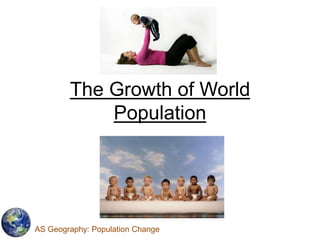
L01 2010 the growth of world population
- 1. The Growth of World Population
- 2. Key Terms Population Distribution – How people are spread across the earth. Population Density – The number of people living in a given area. Usually measured as people per square kilometre.
- 4. Key Terms Birth Rate - A measure of an area’s fertility. It is expressed as number of live births per 1,000 people in 1 year. (Crude Birth Rate) Death Rate – The number of deaths per 1,000 people in 1 year. (Crude Death Rate) Life Expectancy – The average number of years from birth that a person can expect to live.
- 5. Key Terms (con’t) Longevity – the increase in life expectancy over a period of time. It is a direct result of improved medical provision and increased levels of economic development. People live longer and this creates an older population.
- 6. Key Terms (con’t) Natural Change – The change in size of a population caused by the interrelationship between birth and death rates. If birth rate exceeds death rate, a population will increase. If death rate exceeds birth rate, a population will decline.
- 7. Global Population Growth in World population has not taken place evenly.
- 9. Population Change Components of Population Change: Fertility (births) Mortality (deaths) Migration
- 10. Measures of Fertility Crude Birth Rate (CBR) Total Fertility Rate – the average number of children born to a women during her lifetime. Replacement Level Fertility –the level at which each generation has only enough daughters to replace themselves. Approximately 2.12 is replacement rate.
- 11. Measures of Mortality Crude Death Rate Age-Specific Death Rate Age- and Sex- Specific Death Rate Infant Mortality Rate (IMR) – a measure of the number of deaths of infants before their first birthday per 1000 live births. Life Expectancy – the average number of years a person can expect to live. Maternal Mortality Rate – the number of women who die as a result of complications in pregnancy and childbirth. Measured per 1000 live births in a year.
- 12. Causes of Population Growth
- 13. Factors: Health Control of Disease Birth Control Measures Infant Mortality Rates Diet and Malnutrition Numbers of Doctors and Nurses Sexual Health Sanitation
- 14. Factors: Education Health Education Age at Which Compulsory Schooling Finishes Females in Education Levels of Tertiary Education Literacy Levels
- 15. Factors: Social Provision Levels of care for the elderly. Availability of radio and other media. Clean water supply.
- 16. Factors: Cultural Factors Religious attitudes to birth control Status gain from having children. Role of women in society. Sexual morality.
- 17. Factors: Political Factors Taxation to support services Strength of the economy Impact of war and conflicts Access to healthcare and contraception.
- 18. Factors: Environmental Factors Frequency of hazards. Environmental conditions that breed disease.